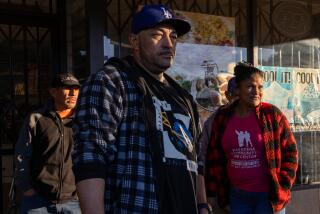2 Workers Turn Rubble Into Profit for Fillmore : Aftermath: Bricks that fell during the Jan. 17 earthquake are being hand-cleaned, then sold for walkways, walls and other local uses.
- Share via
One by one, Bruce Munoz and Jose Herrera slice white mortar from red-clay bricks. Using air-powered chisels, they peel away the cement that once glued together Fillmore’s turn-of-the-century buildings.
The two men work eight hours a day on the huge piles of bricks, literally scraping a profit from the rubble of the Jan. 17 earthquake that devastated downtown Fillmore.
Used brick fetches a premium these days, and these men are converting waste heaps into a popular material for walkways, walls and other brickwork.
When they finish with one, they lug it to a flat wooden pallet nearby. There it joins about 70,000 others hand-cleaned since June. They have a mere 500,000 more to go.
“When we first started off we were using hammers,” said Munoz, cradling a power chisel in his hands. “But we weren’t getting that much done so we started using the gun.”
The bricks rattled loose last January when the 6.8-magnitude quake shook the buildings and their masonry facades. Many of them toppled into Central Avenue; others were deliberately dumped in the street as wrecking crews demolished 17 buildings condemned as unsafe after the quake.
A group of six men was working at the recycling project, but federal earthquake-relief funding was pared earlier this month, leaving the two men to attack the seemingly endless piles by themselves.
It is a hot, dirty job that pays $7-an-hour.
“Sometimes the dust gets into your lungs and you can’t even breathe,” said Herrera, 30, of Fillmore. “Especially on windy days.”
Even before cleaning them, the two men must dig through the rubble-strewn piles to search out the fullest pieces of brick. They spend two or three hours of their day just gathering bricks to clean.
“The boss is a little (upset) because he wants more production,” Herrera said, brushing sweat from his forehead with a chalky right hand. “With six people we could do about four pallets a day. But now we have to stop cleaning the bricks just to go and look for more.”
Funding for their jobs runs out in December, when they hope to have cleaned more than 130,000 bricks. The Fillmore City Council plans to use them in civic projects and offer the bricks to downtown businesses during their reconstruction.
“You can’t do any better than putting (Fillmore) back together with the broken pieces,” Councilman Don Gunderson said.
The rest of the bricks, city officials hope, can be crushed up and used for ground cover at the city baseball diamond, or sold as-is to wholesalers for 25 cents each.
“These are things from real life,” City Engineer Bert J. Rapp said. “Sure, some of them are chipped and some are cracked, but it just adds to the (city’s) character when you build something out of them.”
Some of the used bricks, which tumbled from turn-of-the-century landmarks like the Fillmore Hotel, the Masonic Lodge and the Central Market during the quake, already have been installed at the new sheriff’s substation.
“They made a sidewalk with the bricks,” said Munoz, a 31-year-old father of six from nearby Santa Paula. “That’s pretty neat because I can look back and show my kids what I did.”
Councilman Roger Campbell said he wished he had used some of those bricks to rebuild his home, which was knocked off its foundation in the earthquake. Instead, he bought used bricks for his front porch from another supplier.
“I think it made a real difference in how the house looks,” he said. “But I’m going to buy some from the city and put them somewhere else.”
The councilman said dressing up the re-emerging downtown with recycled bricks will maintain a sense of history.
“It’s a nostalgia thing,” said Campbell, one of the first homeowners to rebuild after the quake. “I don’t think of them as leftovers, I think of them as historical pieces. Besides, it was cheaper to do this than pay the dump fees.”
The City Council decided last week not to hire more help for Herrera and Munoz.
Instead, they will keep as many of the bricks Herrera and Munoz are able to clean and reserve them for future city projects like the planned Central Park. Others they will offer to merchants rebuilding along Central Avenue.
“Obviously, what we want to do is keep bricks in town if we can,” Gunderson said. “It’ll help us keep the look we had before the earthquake, or keep it authentic when it’s restored.”
More to Read
Sign up for Essential California
The most important California stories and recommendations in your inbox every morning.
You may occasionally receive promotional content from the Los Angeles Times.













